Science
RUSSIA 2024: Putin Says Setting Up A Nuclear Power Unit In Space Is A Priority For Russia

According to state news agency TASS, Russian President Vladimir Putin reminded government officials on Thursday that space programs, including establishing a nuclear power unit in space, should be prioritized and funded appropriately.
Putin Says Setting Up A Nuclear Power Unit In Space Is A Priority For Russia
Russia “has good competencies and, moreover, even such reserves that we can be proud of, which we can count on in the future,” Putin said during a meeting with government members, citing a nuclear power unit that would function in space as an example.
“We need to finance it on time,” Putin stated, according to TASS.
“We just need to set priorities,” he added, adding that “there are issues there that require additional attention.”
“It seems that we are all used to the fact that we have such competencies that other countries do not possess, but we need to pay special attention to them so that they develop and can be used in the future to solve those tasks that can and should be solved with the help of these technologies,” Russian President Vladimir Putin said.
According to TASS, Yuri Borisov, the chairman of. the space agency Roscosmos, stated last week that Russia and China are collaborating on a project to build a nuclear reactor on the moon.
“Today, we are seriously considering a project to deliver to the moon and install a power reactor there in collaboration with our Chinese partners sometime between 2033 and 2035,” he stated at a youth festival on March 5.
Putin Says Setting Up A Nuclear Power Unit In Space Is A Priority For Russia
According to TASS, Russia’s State Space Corporation Roscosmos and China’s National Space Administration signed a memorandum of understanding in March 2021 to collaborate on establishing an International Lunar Research Station on behalf of their governments.
The discovery comes after CNN reported last month that Russia is developing a nuclear space weapon capable of crippling a large number of commercial and government satellites.
This new weapon, described as a nuclear EMP by military space scientists, would generate an electromagnetic pulse and a torrent of highly charged particles that would tear across space, disrupting other satellites orbiting Earth.
Putin Says Setting Up A Nuclear Power Unit In Space Is A Priority For Russia
According to Biden administration sources, the weapon is still developing in Russia and has not yet been launched into space. However, if deployed, officials warn it would breach a dangerous threshold in nuclear weapon history and might inflict severe disruptions to everyday life in unpredictable ways.
SOURCE- (CNN)












































